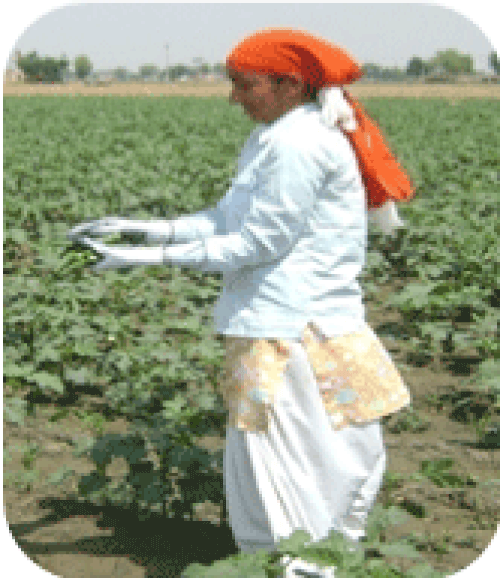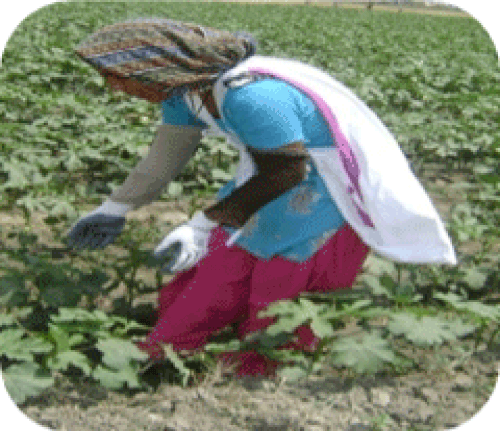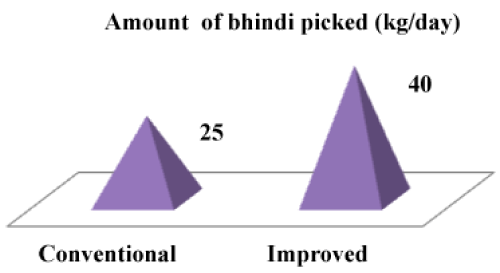Research Article Open Access
Occupational Health Hazard in Abelmoschus esculentus (Bhindi) Picking and Mitigating Measures
| Gandhi S1, Mehta M2* and Dahiya R3 | ||
| 1Scientist Department of FRM, India | ||
| 2College of Home Science, CCS Haryana Agricultural University, HISAR, Haryana, India | ||
| 3DES Home Science Krishi Vigyan Kendras, Fatehabad, Haryana, India | ||
| Corresponding Author : | Mehta M CCS Haryana Agricultural University HISAR,Haryana, India Tel: +91-9416868186 E-mail: mm1964@rediffmail.com |
|
| Received May 30, 2014; Accepted July 04, 2014; Published July 06, 2014 | ||
| Citation: Gandhi S, Mehta M, Dahiya R (2014) Occupational Health Hazard in A.esculentus (Bhindi) Picking and Mitigating Measures. Adv Crop Sci Tech 2:135. doi: 10.4172/2329-8863.1000135 | ||
| Copyright: © 2014 Gandhi, et al. This is an open-access article distributed under the terms of the Creative Commons Attribution License, which permits unrestricted use, distribution, and reproduction in any medium, provided the original author and source are credited. | ||
Related article at Pubmed Pubmed  Scholar Google Scholar Google |
||
Visit for more related articles at Advances in Crop Science and Technology
Abstract
Vegetable A. esculentus (Bhindi) picking is labour-intensive work that requires painstaking physical effort,
patience and perseverance. Women usually use their hands resulting in physical and mental fatigue, hardship, exploitation and pain. The present study was carried out to study the occupational health hazard in vegetable A. esculentus (Bhindi) picking and mitigating measures. The experimental study was carried out on 10 farm women labourers in Majra village of Fatehabad district in A. esculentus (Bhindi) farms, studying use of four types of gloves as existing protective measures used by the respondents and then introduced 3 appropriate technologies viz. protective gloves, capron and vegetable picking bags as mitigating measures. Women workers faced severe health hazards in picking A. esculentus (Bhindi) (lady finger) in terms of cuts and wounds in hands, hardness of skin, itching, blisters and abrasions.Various mitigating measures used by the respondents during A. esculentus (Bhindi) picking were homemade mittens of cloth materials (40%), surgical gloves (30%), cotton (20%) and woolen gloves (10%). Performance evaluation of existing mitigation measures was studied in terms of durability, safety and comfort in terms of sweating, it was highlighted that mittens made of denim cloth were preferred most (Rank I) followed by cotton gloves (Rank II), woolen gloves (Rank III) and surgical gloves (Rank IV). Use of improved technology in A. esculentus (Bhindi) picking not only reduced the health hazards, but also increased the output by 40 percent, thereby, increasing the efficiency of the worker.
| Keywords | |
| Vegetable picking; Health hazard; A. esculentus (Bhindi) ; lady finger; Agricultural operations | |
| Introduction | |
| Most of the works performed by farm women are tedious, tiring as well as time-consuming. These tasks are performed manually or by traditional tools. Workers in agricultural operations for both crop and animal production typically use repetitive motions in awkward positions and which can cause musculoskeletal injuries. (Kirkhorn [1]) Ergonomic risk factors are found in jobs requiring repetitive, forceful, or prolonged exertions of the hands; frequent or heavy lifting, pushing, pulling, or carrying of heavy objects; and prolonged awkward postures. Women are extensively involved in various farm operations like transplanting, weeding, harvesting, processing, marketing and selling of food grains, fruits and vegetables etc. These tasks not only demand considerable time and energy but also are sources of drudgery. Drudgery is generally conceived as physical and mental strain, agony, monotony and hardship experienced by farm women while performing these farm operations. The drudgery prone condition leads to various health and mechanical hazards which creates physical exhaustion fatigue and low productivity. Vegetable A. esculentus (Bhindi) picking is labor-intensive work that requires painstaking physical effort, patience and perseverance. Women usually use their hands resulting in physical and mental fatigue, hardship, exploitation and pain. | |
| Health hazard in A. esculentus (Bhindi) picking | |
| Meyers et al. [2] stated that occupational musculoskeletal disorders (MSDs) might affect muscles, tendons, joints, nerves and related soft tissues anywhere in the body. The lower back and upper extremities, including the neck and shoulders, are the most common sites. Because repeated risk factor exposure of the same muscle, tendon, or region may result in injury and inflammation to the affected area, names such as cumulative trauma disorder, repetitive motion injury, repetition strain injury, and occupational overuse syndrome have been applied to these disorders.Women workers faced severe health hazards in picking A. esculentus (Bhindi) (lady finger) in terms of cuts and wounds in hands, hardness of skin, blisters and abrasions. Moreover, skin allergies due to chemical sprays were commonly an acute problem to 30% of the A. esculentus (Bhindi)-pickers. They were using their own devised methods for protecting themselves against these hazards. Bhattacharya and Chakarbarti [3] reported high prevalence of musculoskeletal disorder among tea leaf pluckers. Shoulders, back, neck and fingers were the most affected organs. Musculoskeletal disorders were mostly related to the work habit i.e. awkward posture, repetitiveness and duration. Hence, urgent need was felt to design a plucking device to lower down the possibilities of MSDs among workers. Park and associates [4] found that farmers have reported having daily LBP for a week (31%), which is significantly greater than the general working population (18.5%). Kaur and Sharma [5] studied that a survey was conducted by taking 200 farm women of Punjab State. The results showed regarding the level of work related body disorders in agriculture by women included pain in many parts of body followed by numbness or stiffness. Some farm women also felt itching and swelling in hands while working in the fields and some felt burning in abdomen and chest especially during spraying of pesticides in the fields due to inhalation. | |
| The reasons of pain or stiffness may be due to the poor body postures while performing certain farm operations and lack of awareness regarding the right body postures. Sometimes, they did not even take rest in between which is essential to make our body stress free. | |
| Methodology | |
| The experimental study was carried out on 10 farm women labourers in A. esculentus (Bhindi) farms of Majra village of Fatehabad district during Front Line Demonstration. use of 4 types of gloves as existing protective measures used by the respondents were studied and 3 appropriate technologies viz. protective gloves, capron/Protective gloves and vegetable picking bags were introduced as mitigating measures. | |
| Capron/protective gloves are made of PVC material on the one side and fusion of cotton or hosiery on the other side. The blending of cotton and hosiery avoids sweating and skin allergies. These gloves protect hands from injury, blisters, cuts, hardness of skin and abrasions. Being a user-friendly technology, these gloves not only protect from health hazards but increase work efficiency of workers. | |
| Protective mask are made of cotton fabric and these cover neck, head and the face of the user. It can be made up to a designed length, depending upon type of use. It avoids dust, husk and straw to penetrate round the neck area. A muslin mask around nose protects from insecticide/pesticide hazards during picking of A. esculentus (Bhindi). The protective mask protects from a harsh environment and direct sun rays. | |
| Pick bag is used to collect vegetables. It is made of cotton cloth and is designed according to anthropometric measurements of women. Shaped pockets are made in front of waist so that picking can be made comfortable as it reduces the hand movements up and down. Cushion belts on shoulders make it easy to carry vegetable loads. Five-six kg A. esculentus (Bhindi) can be picked in one loading. | |
| Results | |
| Existing mitigating measures used by the respondents | |
| Various mitigating measures used by the respondents during A. esculentus (Bhindi) picking were mitten and gloves of different materials (Table 1). Mittens made of denim, and using cloth material with cello tape covering on fingers were mainly used as protective measure against cuts, wounds and itching by 40% of the respondents, followed by surgical gloves (30%), cotton gloves (20%) and woolen gloves (10%). In addition to gloves, others measures were also adopted like wearing suit with full sleeves shirt (70%), using full sleeves gents’ shirt over the dress (40 %), and covering face with head cloth (20%) to protect themselves from itching (Figure 1). | |
| Performance evaluation of existing methods of A. esculentus (Bhindi) picking | |
| Performance evaluation of existing methods of A. esculentus (Bhindi) picking was studied in terms of durability, safety and comfort in terms of sweating. Among the existing methods of A. esculentus (Bhindi) picking mittens made of Denim cloth were preferred most (Rank I) with average mean score of 1.9, cotton gloves (Rank II) scored almost same mean score (mean score of 1.8). Woolen gloves (Rank III) scored 1.2 and surgical gloves (Rank IV) scored minimum (1.0) on all these parameters (Table 2). Although they were using their own devised methods for protecting themselves against these hazards but still they experienced drudgery and had lesser output efficiency (Figure 2). | |
| To minimize these health hazards and enhancing work efficiency of women labourers in A. esculentus (Bhindi)-picking, 10 farm women workers were provided protective garments, viz protective gloves, capron and vegetable picking bags i.e. all these three technologies designed/tested by AICRP, FRM (Figure 3). | |
| Reduction in health hazards using improved technology in A. esculentus (Bhindi) picking | |
| With the use improved technology in A. esculentus (Bhindi) plucking there was reduction in health hazards. Table 3 depict that the utmost reduction (80%) was in incidence of cuts and wounds in hands, hardness of skin and irritation in hands. Blisters and abrasions during A. esculentus (Bhindi) picking were lessen by 70%. The headache was lowered in 20 % workers and other hazards namely suffocation, skin allergies and infection due to spray were reduced by 10% each. However there was no effect of improved technology on chest pain and soar eyes. For this purpose, 75 farm women were selected from five different villages of Ludhiana district. Bal et al. [6] introduced tools viz maize sheller, improved sickle and ring cutter among farm workers and reduction in drudgery was assessed. The parameters for assessment of drudgery experience were drudgery scores, Ovako Work Assessment System, Cardiac Strain Index and Angle of Deviation. The results showed significant reduction in these parameters when improved tools were used as compared to traditional tools. Tiwari and Gite [7] conducted an experiment to study the influence of four workrest schedules on physical workload during power tiller operation and reported that that the work-rest schedules did influence the physiological and postural workload as evidenced by the differences in working heart rate and postural discomfort. It was concluded that to avoid excessive postural discomfort the minimum duration of rest pauses should be of 15 min. The duration of the lunch break should be more than 45 min. | |
| Comparative output given by the respondents in conventional and improved methods of A. esculentus (Bhindi) picking | |
| Use of improved technology in A. esculentus (Bhindi) picking not only reduced the health hazards, but also increased the output thereby increasing the efficiency of the worker. The output increased by 40 percent with the use of these protective technologies (Figure 4). Kaur et al. [8] conducted ergonomic evaluation of vegetable plucking activity with traditional (ordinary knife) and improved tool (ring cutter). Ergonomic assessment of both the method showed that by using ring cutter physiological and muscular stress of workers in terms of heart rate, energy expenditure rate, physiological cost of work and grip fatigue were reduced as compared to traditional method. Thus, new tool i.e. ring cutter was found to be beneficial to improve work efficiency of farm women. | |
| Turner [9] reported that instituting micro pausing might reduce discomfort and pain by reducing muscle and nerve tension. Micro pausing to prevent fatigue is more effective than resting than to recover from it. Micro pauses may be passive where the employee rests and active where the employee undertakes a range of stretching type exercises. | |
| Conclusion | |
| Women workers faced severe health hazards in picking A. esculentus (Bhindi) (lady finger) in terms of cuts and wounds in hands, hardness of skin, itching, blisters and abrasions. In order to overcome these they were using various mitigating measures like homemade mittens of cloth materials (40%), surgical gloves (30%), cotton (20%) and woolen gloves (10%). Performance evaluation of existing mitigation measures was studied in terms of durability, safety and comfort in terms of sweating, it was highlighted that mittens made of denim cloth were most preferred followed by cotton gloves, woolen gloves and surgical gloves . Use of improved technology in A. esculentus (Bhindi) picking not only reduced the health hazards, but also increased the output by 40 percent, thereby, increasing the efficiency of the worker. | |
| References | |
|
|
Tables and Figures at a glance
| Table 1 | Table 2 | Table 3 |
Figures at a glance
 |
 |
 |
 |
|||
| Figure 1 | Figure 2 | Figure 3 | Figure 4 |
Relevant Topics
- Agricultural science
- Agronomy
- Climate impact on crops
- Crop Productivity
- Crop Sciences
- Crop Technology
- Field Crops Research
- Hybrid Seed Technology
- Irrigation Technology
- Organic Cover Crops
- Organic Crops
- Pest Management
- Plant Genetics
- Plant Breeding
- Plant Nutrition
- Seed Production
- Seed Science and Technology
- Soil Fertility
- Weed Control
Recommended Journals
Article Tools
Article Usage
- Total views: 15494
- [From(publication date):
November-2014 - Sep 04, 2025] - Breakdown by view type
- HTML page views : 10771
- PDF downloads : 4723
